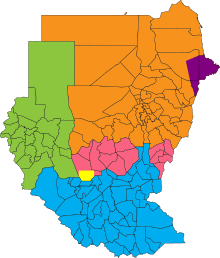The Comprehensive Peace Agreement (CPA, Arabic: اتفاقية السلام الشامل, romanized: Ittifāqiyyah al-salām al-šāmil), also known as the Naivasha Agreement, was an accord signed on 9 January 2005, by the Sudan People's Liberation Movement (SPLM) and the Government of Sudan.[1] The CPA was meant to end the Second Sudanese Civil War, develop democratic governance countrywide, and share oil revenues. It also set a timetable for a Southern Sudanese independence referendum.

The peace process was encouraged by the Intergovernmental Authority on Development (IGAD), in addition to a "troika" of donor countries comprising the United States, United Kingdom, and Norway.[2]
Components
editThe process resulted in the following agreements (also referred to as protocols):
- The Machakos Protocol (or Chapter I), signed in Machakos, Kenya on 20 July 2002. Agreement on broad principles of government and governance.
- The Protocol on Power Sharing (or Chapter II), signed in Naivasha, Kenya on 26 May 2004
- The Agreement on Wealth Sharing (or Chapter III), signed in Naivasha, Kenya on 7 January 2004
- The Protocol on the Resolution of the Conflict in Abyei Area (or Chapter IV), signed in Naivasha, Kenya on 26 May 2004
- The Protocol on the Resolution of the Conflict in Southern Kordofan and Blue Nile States (or Chapter V), signed in Naivasha, Kenya on 26 May 2004
- The Agreement on Security Arrangements (or Chapter VI), signed in Naivasha, Kenya on 25 September 2003
- The Permanent Ceasefire and Security Arrangements Implementation Modalities and Appendices (or Annexure I), signed in Naivasha, Kenya on 30 October 2004
- The Implementation Modalities and Global Implementation Matrix and Appendices (or Annexure II), signed in Naivasha, Kenya, on 31 December 2004
The final, comprehensive agreement was signed on 9 January 2005 and marked the commencement of implementation activities.
Implementation
edit2007 Southern withdrawal
editOn 11 October 2007, the SPLM withdrew from the government of national unity (GoNU), accusing the central government of violating the terms of the CPA. In particular, the SPLM states that the Khartoum-based government, which is dominated by the National Congress Party, has failed to withdraw over 15,000 troops from southern oilfields and failed to implement the Protocol on Abyei. The SPLM stated that it was not returning to war, while analysts noted that the agreement had been disintegrating for some time, notably because of international focus on the conflict in nearby Darfur.[3]
The SPLM announced that it was rejoining the government on 13 December 2007, following an agreement. The agreement states that the seat of government will rotate between Juba and Khartoum every three months, though it appears that this will be largely symbolic, as well as funding for a census (vital for the referendum) and a timetable for the withdrawal of troops across the border.[4]
Northern Sudanese troops finally left Southern Sudan on 8 January 2008.[5]
South Sudan Independence
editA referendum was held from 9 to 15 January 2011 to determine if South Sudan should declare its independence from Sudan, with 98.83% of the population voting for independence. It became independent as the Republic of South Sudan on 9 July 2011.
Popular Consultations
editPopular consultations for Blue Nile and South Kordofan were suspended[when?] as part of the ongoing conflict in those regions between the northern wing of the SPLA and the Justice and Equality Movement against the central government.[6]
See also
editReferences and notes
edit- ^ "Sudan Comprehensive Peace Agreement". Peace Accords Matrix. Kroc Institute for International Peace Studies, University of Notre Dame. Retrieved 16 July 2016.
- ^ Srinivasan, Sharath (2021) When Peace Kills Politics: International Intervention and Unending Wars in the Sudans, Hurst & Co/Oxford University Press ISBN 9780197602720
- ^ "SUDAN: Southern pull-out threatens peace deal" Archived 13 February 2012 at the Wayback Machine, IRIN, 11 October 2007
- ^ "Sudan to have shuttle government", BBC News, 13 December 2007
- ^ "AFP: North Sudan troops complete southern withdrawal: ex-rebels". Archived from the original on 25 September 2010. Retrieved 25 September 2010.
- ^ "Sudan's Spreading Conflict (I): War in South Kordofan Crisis Group Africa Report N°198, 14 February 2013" (PDF). Archived from the original (PDF) on 17 July 2019. Retrieved 3 May 2019.
External links
edit- Full text of the Comprehensive Peace Agreement, UN Peacemaker
- Read all peace agreements for Sudan, UN Peacemaker
- UNMIS.org, the official web site of the United Nations Mission in Sudan (UNMIS)
- Updated Timeline of the Implementation of the Comprehensive Peace Agreement in Sudan[permanent dead link], Center for International Peace Operations (ZIF), April 2009
- Sudan: Human Rights Accountability Must Be Part of North-South Peace Agreement, Human Rights Watch, November 2004
- "Sudan after the Naivasha Peace Agreement: No Champagne Yet" by Denis M. Tull, German Institute for International and Security Affairs, 3 February 2005
- The Khartoum-SPLM Agreement: Sudan's Uncertain Peace, International Crisis Group, 25 July 2005
- Sudan’s Comprehensive Peace Agreement: The Long Road Ahead, International Crisis Group, 31 March 2006
- Sudan’s Comprehensive Peace Agreement: Beyond the Crisis, International Crisis Group, 13 March 2008